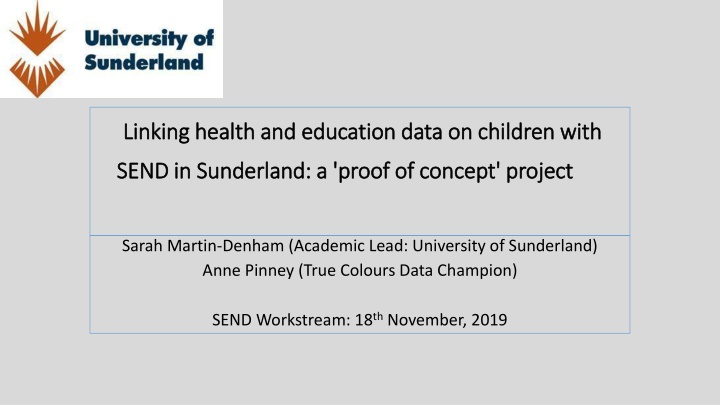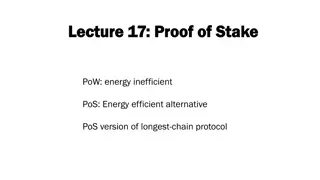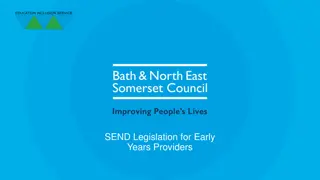Linking Health and Education Data on Children with SEND: A Proof of Concept Project
This project in Sunderland aims to link health and education data for children with Special Educational Needs and Disabilities (SEND) to better understand their needs, target support effectively, inform training needs, and enhance service design across England. By integrating data from various sources, including paediatric disability reports and school census data, the goal is to develop a data-driven support model to improve outcomes for disabled children. The initiative leverages the Disability Complexity Scale developed in Sunderland for future healthcare funding models.
Download Presentation

Please find below an Image/Link to download the presentation.
The content on the website is provided AS IS for your information and personal use only. It may not be sold, licensed, or shared on other websites without obtaining consent from the author.If you encounter any issues during the download, it is possible that the publisher has removed the file from their server.
You are allowed to download the files provided on this website for personal or commercial use, subject to the condition that they are used lawfully. All files are the property of their respective owners.
The content on the website is provided AS IS for your information and personal use only. It may not be sold, licensed, or shared on other websites without obtaining consent from the author.
E N D
Presentation Transcript
Linking health and education data on children with Linking health and education data on children with SEND in Sunderland: a 'proof of concept' project SEND in Sunderland: a 'proof of concept' project Sarah Martin-Denham (Academic Lead: University of Sunderland) Anne Pinney (True Colours Data Champion) SEND Workstream: 18thNovember, 2019
Background to this project 1. CDC-True Colours report (Feb. 2017) Included recommendations on: supporting & incentivising paediatric disability data developing robust, integrated data on disabled children
Background to this project (2) 2. Office of the Children s Commissioner Children with vulnerabilities data framework Data for Children Partnership aiming to improve the use of Government administrative data to better understand the needs and interests of children in England. Lead partners: Children s Commissioner, ONS, Administrative Data Research UK (a programme of UK Research and Innovation, the University of Oxford. 3. ESRC-ONS ambitions to link national administrative datasets, with a variety of new funding opportunities opening up.
Linking health and education data on children with Linking health and education data on children with SEND in Sunderland: a 'proof of concept' project SEND in Sunderland: a 'proof of concept' project Sarah Martin-Denham (Academic Lead: University of Sunderland)
Why link health and school data? Data to be linked: Paediatric Disability data reported to the Community Services Dataset and Emergency Care Data Set + School Census data LOCAL AIMS To better understand levels of need and vulnerability among children with SEND To target support more effectively and to inform local training needs To inform intelligent interagency service design that improves outcomes for children and young people. To prepare nurseries, schools and other educational contexts for children coming into or already in their care NATIONAL To develop a multi-agency, data-driven model of support for disabled children, which would have application across England.
Why Sunderland? The Disability Complexity Scale developed in Sunderland underpins the future model for healthcare funding for disabled children (SEND currency); engaged with NHS England and NHS Digital who are piloting the Scale. Uniquely (at present) to Sunderland, a multi-faceted but standardised data capture takes place at the point of care across all outpatient and special school clinics, with the knowledge and support of children and families. Data on all children and young people attending the Paediatric Emergency Department are reported to NHS Digital s Emergency Care Data Set. There is a well-established, interagency strategic partnership for disabled children in Sunderland, with representation from a children s participation lead, caregivers, commissioners and providers across statutory and voluntary sectors. They are strongly behind this proposal.
The partners Local (already on board) University of Sunderland South Tyneside and Sunderland NHS Foundation Trust Sunderland Clinical Commissioning Group North of England Commissioning Support Unit Sunderland Parent Carer Forum Together for Children Sunderland City Council Public Health England National (to develop) Data for Children Partnership, led by the Office of the Children s Commissioner Council for Disabled Children/True Colours Trust ONS DfE DHSC NHS England Public Health England Ofsted CQC
Proposed programme of work in the proof of concept stage (year one) Explore and demonstrate the rich potential of paediatric disability data 1. Report the benefits of a standardised interface for health professionals to capture the multifaceted needs of children as high quality data, at the point of care. 2. Liaise with NHS Digital, NHS England, Public Health England, Department for Education, Office for National Statistics, and the Children s Commissioner for England to propose a data process model that takes paediatric disability data through to a national data resource. Explore and demonstrate the value of linking health and education data on disabled children 3. Combine these datasets on children with SEND in Sunderland: paediatric data reported to the Community Services Dataset and Emergency Care Data Set with School Census data 4. Consult with policymakers and public services providers to ensure the data design meets their research and analysis requirements.
Explore how to do this in a way that meets legal, ethical & information governance requirements 5. Identify and report the requirements for the ethical use of these data and the required data governance, legal gateways, information security requirements and data management provisions. Develop a cost effective data-driven model with national application 6. Propose a model with the agreed solutions to these requirements that has the support of the data owners and other stakeholders. 7. Present and nominally assign the costs and benefits should the model be adopted by the stakeholders and data owners, in the form of a costed recommendation to UKRI, NHS England, NHS Digital, Department for Education, Office for National Statistics, and any other key stakeholder identified in the work. 8. Obtain agreement in principle with the decision-making bodies such that this model can be scheduled for implementation in a sustainable manner.
Impact and public benefit To deliver a healthier future that is within our reach, we need a new paradigm for research. All health-related data, genomics to social determinants, and every patient contact need to be used to improve the experience, service and prevention for each individual. [Chief Medical Officer s report] We lack of joined-up data on disabled children to inform service planning and commissioning locally or to understand population trends, such as the apparent increase in number of children with complex disabilities. Administrative datasets are a significant information resource for Government to manage, monitor, assess and review services. By bringing together data sets, there is greater scope for in-depth analysis, for example, to better understand pathways through services, outcomes and gaps in provision. There are significant barriers to data linkage and no single national model is yet emerging, which hinders the efficient and effective use of the available data.
Beyond the proof of concept Mental Health Services Data Set CAMHS CYPS NHS Digital s Emergency Care Data Set Hospital Episode Statistics Community Services Data Set Pre-natal Screening Data The EYFS progress check at age two School Census Data England and Wales Census data Other? Each data source has complex data access arrangements, costs and barriers which may outweigh potential benefits. We want to design a model that can be adopted by national agencies to the benefit of research, analytics, and local health and care service provision helping to minimize costs and burdens, while maximizing potential benefits.


![Read⚡ebook✔[PDF] Linking the Space Shuttle and Space Stations: Early Docking Te](/thumb/21519/read-ebook-pdf-linking-the-space-shuttle-and-space-stations-early-docking-te.jpg)




















